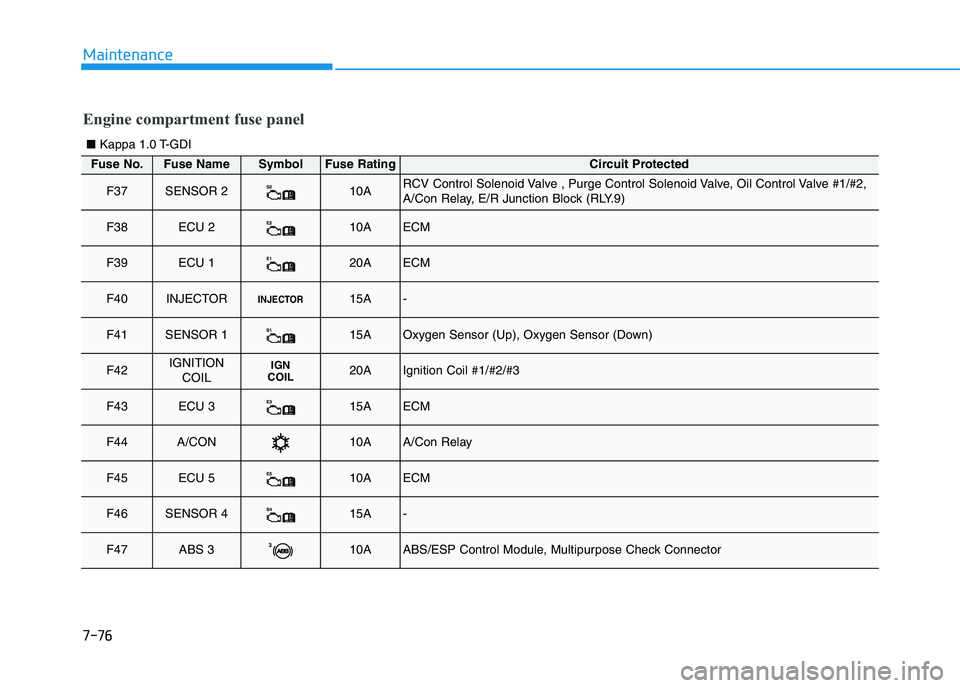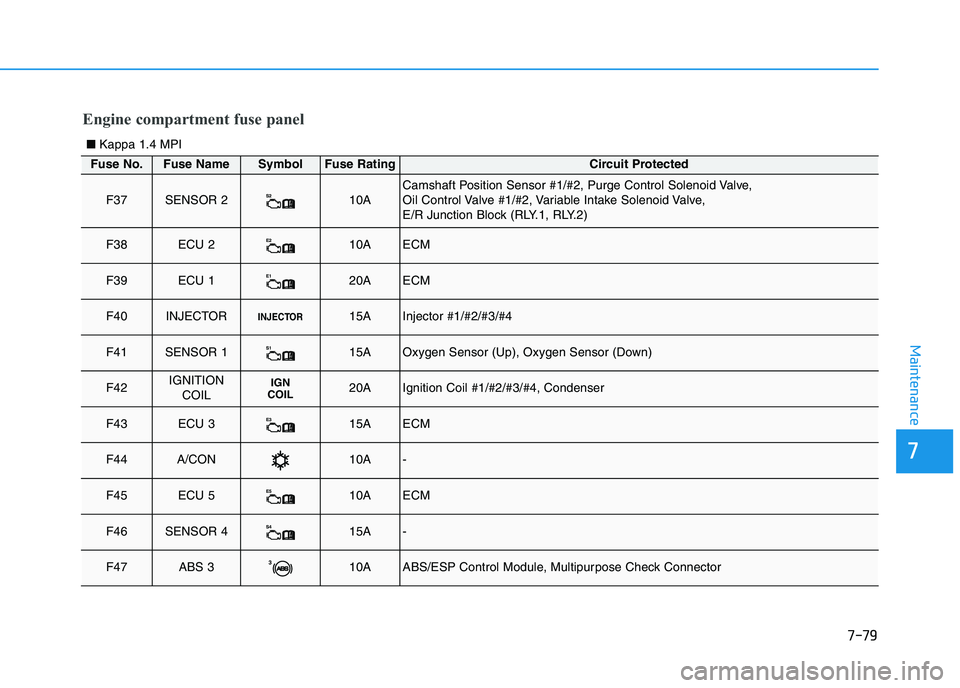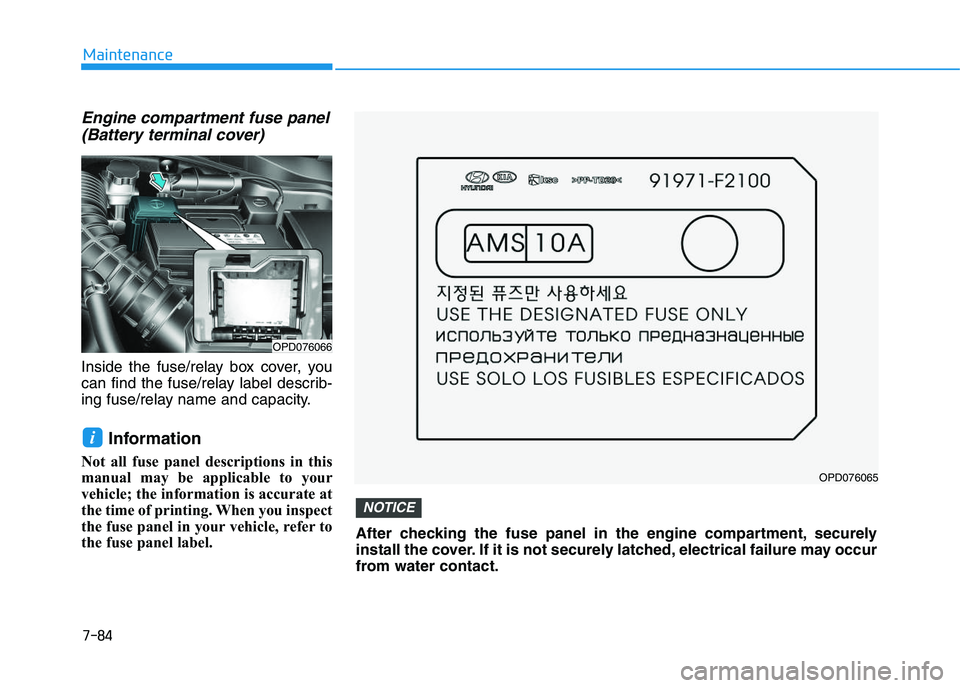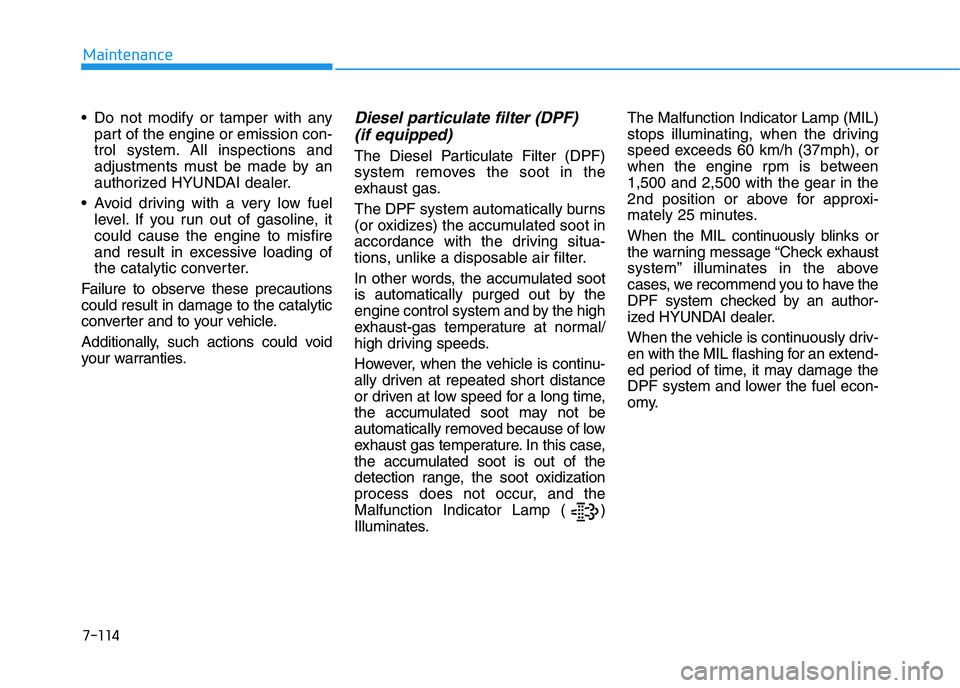check engine HYUNDAI I30 2022 Manual Online
[x] Cancel search | Manufacturer: HYUNDAI, Model Year: 2022, Model line: I30, Model: HYUNDAI I30 2022Pages: 659, PDF Size: 17.14 MB
Page 589 of 659

7-76
Maintenance
Fuse No.Fuse NameSymbolFuse RatingCircuit Protected
F37SENSOR 2S210ARCV Control Solenoid Valve , Purge Control Solenoid Valve, Oil Control Valve #1/#2,
A/Con Relay, E/R Junction Block (RLY.9)
F38ECU 2E210AECM
F39ECU 1E120AECM
F40INJECTORINJECTOR15A-
F41SENSOR 1S115AOxygen Sensor (Up), Oxygen Sensor (Down)
F42IGNITION
COILIGN
COIL20AIgnition Coil #1/#2/#3
F43ECU 3E 315AECM
F44A/CON10AA/Con Relay
F45ECU 5E510AECM
F46SENSOR 4S415A-
F47ABS 3310AABS/ESP Control Module, Multipurpose Check Connector
Engine compartment fuse panel
■ Kappa 1.0 T-GDI
Page 591 of 659

7-78
Maintenance
Fuse No.Fuse NameSymbolFuse RatingCircuit Protected
F42IGNITIONCOILIGN
COIL20AIgnition Coil #1/#2/#3/#4
F43ECU 3E 315AECM
F44A/CON10AA/Con Relay
F45ECU 5E510AECM
F46SENSOR 4S415AVacuum Pump
F47ABS 3310AABS/ESP Control Module, Multipurpose Check Connector
F48TCU 2T215ATCM, Transaxle Range Switch, E/R Junction Block (Fuse : F34)
F49SENSOR 3S310AE/R Junction Block (RLY.7)
F50ECU 4E415AECM
F51WIPER25AWiper Relay
F52HORN15AHorn Relay
Engine compartment fuse panel
■ Kappa 1.4 T-GDI
Page 592 of 659

7-79
7
Maintenance
Engine compartment fuse panel
Fuse No.Fuse NameSymbolFuse RatingCircuit Protected
F37SENSOR 2S210ACamshaft Position Sensor #1/#2, Purge Control Solenoid Valve,
Oil Control Valve #1/#2, Variable Intake Solenoid Valve,
E/R Junction Block (RLY.1, RLY.2)
F38ECU 2E210AECM
F39ECU 1E120AECM
F40INJECTORINJECTOR15AInjector #1/#2/#3/#4
F41SENSOR 1S115AOxygen Sensor (Up), Oxygen Sensor (Down)
F42IGNITION
COILIGN
COIL20AIgnition Coil #1/#2/#3/#4, Condenser
F43ECU 3E 315AECM
F44A/CON10A-
F45ECU 5E510AECM
F46SENSOR 4S415A-
F47ABS 3310AABS/ESP Control Module, Multipurpose Check Connector
■ Kappa 1.4 MPI
Page 594 of 659

7-81
7
Maintenance
Engine compartment fuse panel
■ Gamma 1.6 MPI
Fuse No.Fuse NameSymbolFuse RatingCircuit Protected
F42IGNITION
COILIGN
COIL20AIgnition Coil #1/#2/#3/#4, Condenser
F43ECU 3E 315AECM/PCM
F44A/CON10A-
F45ECU 5E510AECM/PCM
F46SENSOR 4S415A-
F47ABS 3310AABS/ESP Control Module, Multipurpose Check Connector
F48TCU 2T215ATransaxle Range Switch, E/R Junction Block (Fuse : F34)
F49SENSOR 3S310AE/R Junction Block (RLY.7)
F50ECU 4E415AECM/PCM
F51WIPER25AWiper Relay
F52HORN15AHorn Relay
Page 596 of 659

7-83
7
Maintenance
Fuse No.Fuse NameSymbolFuse RatingCircuit Protected
F47ABS 3310AABS/ESP Control Module, Multipurpose Check Connector
F48TCU 2T215ATCM, Transaxle Range Switch, E/R Junction Block (Fuse : F34)
F49SENSOR 3S310AAir Flow Sensor, Rail Pressure Control Valve, Camshaft Position Sensor,
Oil Pressure Valve, E/R Junction Block (RLY.7)
F50ECU 4E415A-
F51WIPER25AWiper Relay
F52HORN15AHorn Relay
Engine compartment fuse panel
■ U-II 1.6 TCI
Page 597 of 659

7-84
Maintenance
Engine compartment fuse panel(Battery terminal cover)
Inside the fuse/relay box cover, you
can find the fuse/relay label describ-
ing fuse/relay name and capacity.
Information
Not all fuse panel descriptions in this
manual may be applicable to your
vehicle; the information is accurate at
the time of printing. When you inspect
the fuse panel in your vehicle, refer to
the fuse panel label.
i
OPD076066
OPD076065
After checking the fuse panel in the engine compartment, securely
install the cover. If it is not securely latched, electrical failure may occur
from water contact.
NOTICE
Page 613 of 659

7-100
Maintenance
4. Remove the socket from the assembly by turning the socket
counterclockwise until the tabs on
the socket align with the slots on
the assembly.
5. Remove the bulb by pulling it straight out.
6. Insert a new bulb by inserting it into the socket and rotating it until
it locks into place.
7. Install the socket into the assembly by aligning the tabs on the socket
with the slots in the assembly.
Push the socket into the assembly
and turn the socket clockwise.
8. Reinstall the service cover.
Type B
(1) Stop/Tail lamp
(2) Turn signal lamp
(3) Backup lamp
Stop/Tail lamp
If the LED lamp does not operate,
have the vehicle checked by an
authorized HYUNDAI dealer.
Turn signal lamp
1. Turn off the engine.
2. Open the tailgate.
3. Open the lamp assembly retaining screw covers.
4. Loosen the lamp assembly retain- ing screws with a cross-tip screw-
driver.
OPD076046
OPD076052
Backup lamp
Tail lamp
OPD076047
Page 625 of 659

7-112
MaintenanceEngine exhaust gases contain
carbon monoxide (CO). Though
colorless and odorless, it is dan-
gerous and could be lethal if
inhaled. Follow the instructions
following to avoid CO poisoning.
WARNING
Canister
Fuel vapors generated inside the fuel
tank are absorbed and stored in the
onboard canister. When the engine is
running, the fuel vapors absorbed in
the canister are drawn into the surge
tank through the purge control sole-
noid valve.
Purge Control Solenoid Valve(PCSV)
The purge control solenoid valve is
controlled by the Engine Control
Module (ECM); when the engine
coolant temperature is low during
idling, the PCSV closes so that evap-
orated fuel is not taken into the
engine. After the engine warms-up
during ordinary driving, the PCSV
opens to introduce evaporated fuel to
the engine.
3. Exhaust emission control system
The Exhaust Emission Control System
is a highly effective system which con-
trols exhaust emissions while main-
taining good vehicle performance.
Vehicle modifications
This vehicle should not be modified.
Modification of your vehicle could
affect its performance, safety or
durability and may even violate gov-
ernmental safety and emissions reg-
ulations.
In addition, damage or performance
problems resulting from any modifi-
cation may not be covered under
warranty.
If you use unauthorized electronic
devices, it may cause the vehicle to
operate abnormally, wire damage,
battery discharge and fire. For your
safety, do not use unauthorized
electronic devices.
Engine exhaust gas precautions (carbon monoxide)
Carbon monoxide can be present
with other exhaust fumes. Therefore,
if you smell exhaust fumes of any
kind inside your vehicle, have it
inspected and repaired immediately.
If you ever suspect exhaust fumes
are coming into your vehicle, drive it
only with all the windows fully open.
Have your vehicle checked and
repaired immediately.
Page 627 of 659

7-114
Maintenance
Do not modify or tamper with any part of the engine or emission con-
trol system. All inspections and
adjustments must be made by an
authorized HYUNDAI dealer.
Avoid driving with a very low fuel level. If you run out of gasoline, it
could cause the engine to misfire
and result in excessive loading of
the catalytic converter.
Failure to observe these precautions
could result in damage to the catalytic
converter and to your vehicle.
Additionally, such actions could void
your warranties.
Diesel particulate filter (DPF) (if equipped)
The Diesel Particulate Filter (DPF)
system removes the soot in the
exhaust gas.
The DPF system automatically burns
(or oxidizes) the accumulated soot in
accordance with the driving situa-
tions, unlike a disposable air filter.
In other words, the accumulated soot
is automatically purged out by the
engine control system and by the high
exhaust-gas temperature at normal/
high driving speeds.
However, when the vehicle is continu-
ally driven at repeated short distance
or driven at low speed for a long time,
the accumulated soot may not be
automatically removed because of low
exhaust gas temperature. In this case,
the accumulated soot is out of the
detection range, the soot oxidization
process does not occur, and the
Malfunction Indicator Lamp ( )
Illuminates. The Malfunction Indicator Lamp (MIL)
stops illuminating, when the driving
speed exceeds 60 km/h (37mph), or
when the engine rpm is between
1,500 and 2,500 with the gear in the
2nd position or above for approxi-
mately 25 minutes.
When the MIL continuously blinks or
the warning message “Check exhaust
system” illuminates in the above
cases, we recommend you to have the
DPF system checked by an author-
ized HYUNDAI dealer.
When the vehicle is continuously driv-
en with the MIL flashing for an extend-
ed period of time, it may damage the
DPF system and lower the fuel econ-
omy.
Page 637 of 659

8-9
8
Specifications & Consumer information
Recommended engine oil (For Europe)
Supplier ProductShell Gasoline Engine
HELIX ULTRA AH-E 5W-30
HELIX ULTRA 5W-40
Diesel Engine HELIX ULTRA AP 5W-30
HELIX ULTRA AP-L 5W-30
Always be sure to clean the area around any filler plug, drain plug, or dipstick before checking or draining
any lubricant. This is especially important in dusty or sandy areas and when the vehicle is used on unpaved
roads. Cleaning the plug and dipstick areas will prevent dirt and grit from entering the engine and other
mechanisms that could be damaged.
CAUTION
Recommended SAE viscosity number
Engine oil viscosity (thickness) has an effect on fuel economy and cold weather operating (engine start and engine oil
flowability). Lower viscosity engine oils can provide better fuel economy and cold weather performance, however, high-
er viscosity engine oils are required for satisfactory lubrication in hot weather. Using oils of any viscosity other than
those recommended could result in engine damage.